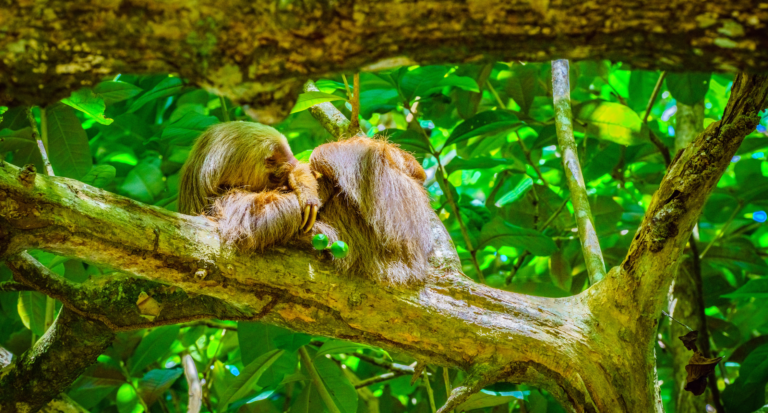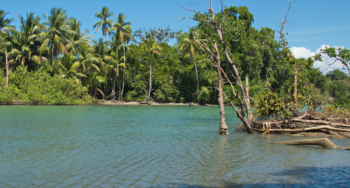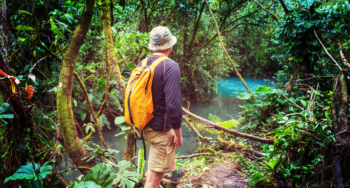Cahuita National Park: What's Covered
Cahuita National Park combines Caribbean reef snorkeling with rainforest hiking along a 5-mile coastal trail where howler monkeys and sloths hang out in the trees above pristine beaches. Located 3.5 hours from San José via Route 32 through Braulio Carrillo, this 2,639-acre park has two entrances—Kelly Creek operates on donations while Puerto Vargas charges $5. Having your own vehicle lets you explore both entrances plus nearby Punta Uva and Manzanillo beaches.
Quick Facts: • Park protects 600 acres of living coral reef—Costa Rica’s only Caribbean reef system • Trail difficulty: Easy to moderate, flat terrain takes 3-4 hours one-way • Best snorkeling visibility: February-April (15-30 feet) and September-October • Standard vehicles work fine—Route 32 from SJO doesn’t require 4WD • Wildlife peaks morning through midday, unlike Manuel Antonio where activity drops by 9am
Top 3 Trail Options:
- Punta Cahuita Round Trip – Most popular 3km hike (90 minutes each way) from Kelly Creek to the peninsula with the park’s calmest swimming and best snorkeling spot
- Full Coastal Trail – Complete 5-mile journey between Kelly Creek and Puerto Vargas takes 3-4 hours one-way, requiring taxi coordination or vehicle at both ends
- Puerto Vargas Direct Access – Drive straight to this southern entrance for immediate beach access with facilities, picnic areas, and shorter trail sections
Your Caribbean coast adventure extends beyond just the park—combine Cahuita with Punta Uva’s stunning beach, Puerto Viejo’s restaurants, and the Sloth Sanctuary, all within a 30-minute drive when you avoid common first-time mistakes.
If you need any help with a Costa Rica Car Rental, contact us now!
Cahuita National Park offers something most Costa Rican parks don’t: the chance to combine rainforest hiking and world-class snorkeling in a single morning. Located on the Caribbean coast near the town of Cahuita, this 2,639-acre park protects both coastal jungle and one of Costa Rica’s healthiest coral reef systems. You’ll spot howler monkeys swinging through the canopy, three-toed sloths lounging in cecropia trees, and if you time your snorkel right, sea turtles gliding through crystal-clear water just offshore. The best part? The main entrance operates on a donation basis as it is comanaged with the community, making this one of the most accessible national parks in the country.
What sets Cahuita apart from places like Manuel Antonio is the vibe. The Afro-Caribbean influence creates a completely different atmosphere—reggae rhythms drift from nearby town, coconut-infused cuisine replaces typical Costa Rican fare, and the pace of life slows noticeably. The park itself sees far fewer visitors than the Pacific coast destinations, meaning you’ll often have sections of the 5-mile coastal trail completely to yourself.
Key Takeaways
- Cahuita combines coastal rainforest hiking with Caribbean snorkeling in one location
- Kelly Creek entrance accepts donations (suggested $5); Puerto Vargas charges $5 fixed fee
- The 5-mile coastal trail takes 3-4 hours one-way with wildlife spotting stops
- Best snorkeling happens February-April and September-October when water clarity peaks
- Howler monkeys, sloths, capuchin monkeys, and 125+ bird species live in the park
- The park sits 3.5 hours from San José via Route 32 through Braulio Carrillo
- Having your own vehicle lets you explore both park entrances plus nearby Punta Uva and Manzanillo beaches
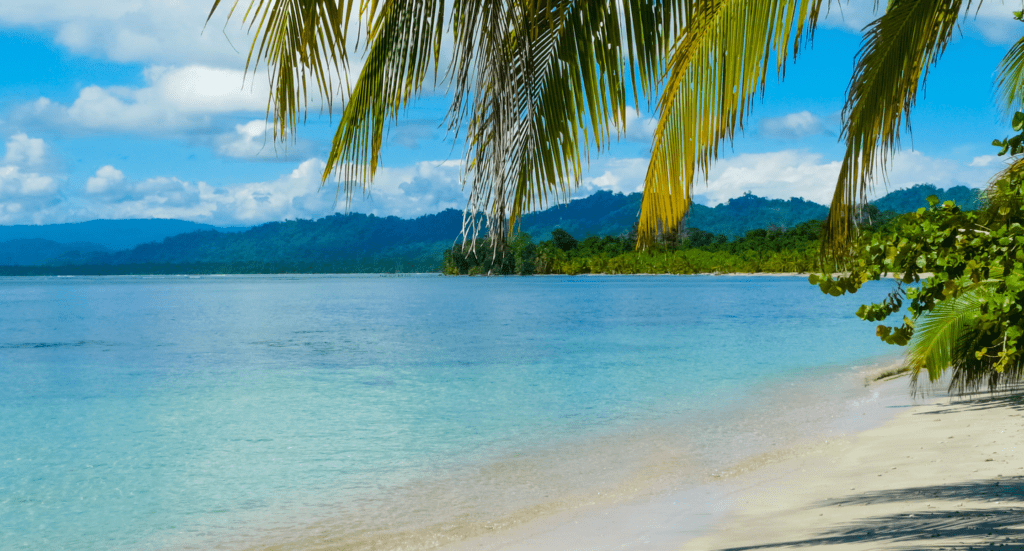
What Makes Cahuita Different from Other Costa Rican National Parks?
Most visitors head straight to the Pacific coast, leaving Cahuita blissfully under the radar. This park protects 600 acres of coral reef—the only living coral reef on Costa Rica’s Caribbean coast. While you’re hiking through rainforest watching for wildlife, you’re also walking parallel to underwater gardens where parrotfish, angelfish, and spotted eagle rays navigate the coral formations.
The ecosystem here differs dramatically from Pacific coast parks. Caribbean rainfall patterns create denser vegetation, and the Afro-Caribbean influence extends beyond culture into the landscape itself. You’ll notice coconut palms mixed with rainforest trees, a combination you won’t find on the Pacific side.
The park’s two-entrance system creates flexibility most parks lack. Enter at Kelly Creek (donation-based) for the full 5-mile trail experience, or drive to Puerto Vargas entrance if you want direct beach with facilities. Both entrances connect via the same coastal trail, but they serve different visitor needs.
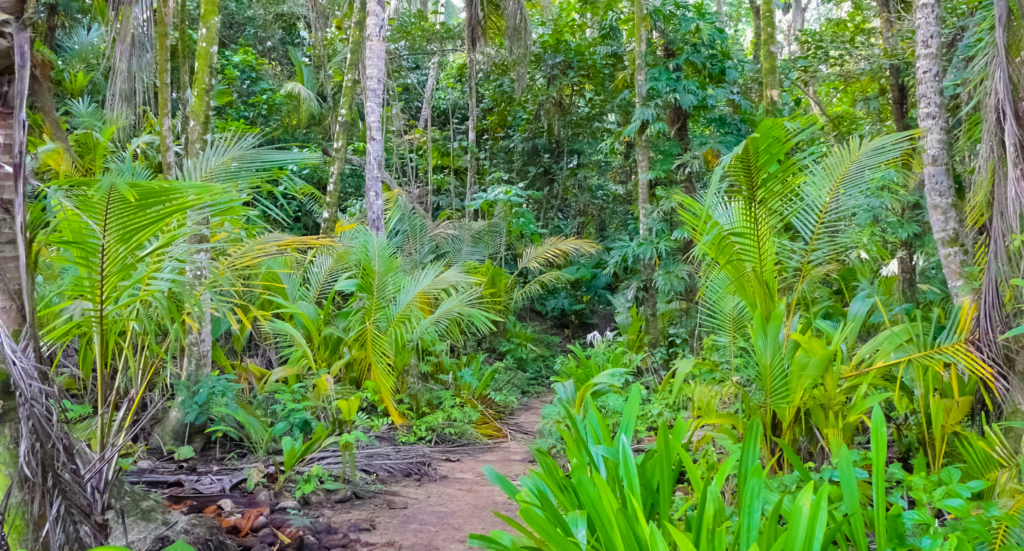
Which Entrance Should You Choose: Kelly Creek or Puerto Vargas?
Kelly Creek Entrance sits right in Cahuita town—walk from most hotels in under 10 minutes. This entrance operates on a donation basis (locals suggest $5, but you determine what you pay). The trail starts here and runs south along the coast for 5 miles to Puerto Vargas.
The donation system exists because local community members manage this entrance through an agreement with the national park system. Your contribution supports both park maintenance and the local community directly. There are restrooms and showers near the entrance and picnic seating along the trail.
Puerto Vargas Entrance requires a 5km drive south of Cahuita town (10 minutes). This official park entrance charges the standard $5 fee and offers proper facilities: clean restrooms, picnic areas with tables, parking, and a ranger station.
Pro tip: Consider taking a snorkeling trip and starting your hike from Cahuita Point to head back toward the town over a couple of hours with a few ocean dips to freshen off!
The Malecon or Marine Facilities
Snorkelling or boat tours depart from the park entrance behind the primary school. Visitors pay a donation (which is valid for the Kelly Creek entrance too) and can access the restrooms.
What Wildlife Will You Actually See in Cahuita?
Cahuita delivers on wildlife without requiring a 6am wake-up call. The coastal forest here stays active throughout the morning, unlike some parks where animal activity drops by 9am.
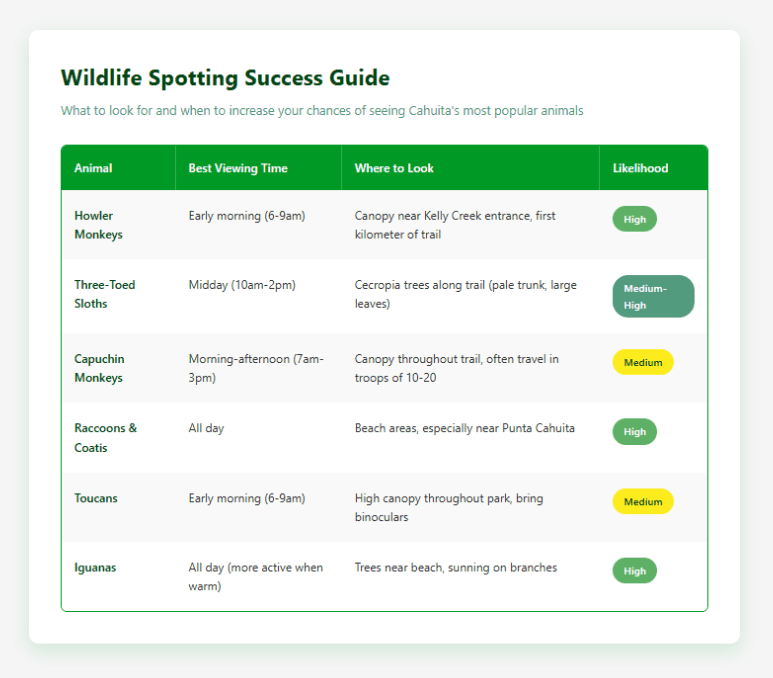
Wildlife spotting guide table for Cahuita National Park showing six animals with their best viewing times, locations, and likelihood of sighting. Howler monkeys, iguanas, and raccoons/coatis have high likelihood ratings. Three-toed sloths have medium-high likelihood. Capuchin monkeys and toucans have medium likelihood. Table uses Vamos brand colors with green headers and yellow/green badges.
Howler monkeys are the park’s soundtrack. These black primates produce roars that carry for miles—you’ll hear them long before spotting them. Look up into the canopy along the first kilometer of trail where troops frequently feed in the morning. They move slowly, making photography easier than with the hyperactive capuchins. Keep your nose active too – the howler monkey droppings are often the first sign that the troop is ahead!
Three-toed sloths appear more often than you’d expect. Scan the cecropia trees (pale trunk, large segmented leaves) about 30-60 minutes into the trail. Sloths feed almost exclusively on cecropia leaves, so learning to identify these trees improves your spotting success dramatically. Midday heat makes sloths more visible as they move to shadier branches and they’ll also be surprisingly active in the rain.
White-faced capuchin monkeys travel in troops of 10-20, moving fast through the canopy. These smaller monkeys show more curiosity about humans than howlers, occasionally approaching close to the trail. Keep food secured—capuchins have figured out backpack zippers.
Raccoons and coatis patrol the beaches, especially near Punta Cahuita. These animals have become habituated to humans, sometimes too comfortable approaching visitors. Never feed them despite how “cute” they appear—it disrupts their natural feeding patterns and makes them aggressive toward future visitors.
The bird diversity here tops 125 species, including toucans, green herons, kingfishers, and the elusive boat-billed heron. Bring binoculars if bird photography interests you—many species stay high in the canopy.
When Does Snorkeling Actually Work at Cahuita?
Cahuita’s snorkeling reputation is well-deserved, but water clarity varies dramatically by season. The Caribbean doesn’t follow the Pacific coast’s neat dry/wet season pattern.
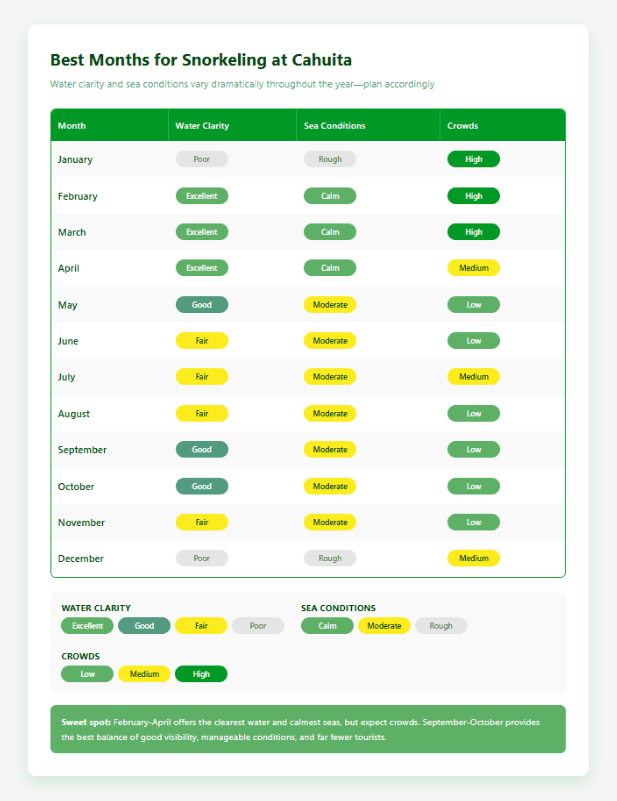
February through April offers the most consistent visibility—often 15-30 feet. The combination of less rainfall and calmer seas creates ideal snorkeling conditions. This window represents your best bet for seeing the coral formations clearly and spotting the reef’s residents: angelfish, parrotfish, damselfish, sergeant majors, and occasionally sea turtles or stingrays.
September and October provide a second opportunity window. Rainfall drops between the intense May-August pattern and the November-January wetness, and the seas calm enough for decent visibility. You’ll find far fewer tourists during these months while still getting good underwater conditions.
Avoid December through January for snorkeling despite the dry season timing. This period brings rough seas and churned-up sediment from wave action, reducing visibility to just a few feet. The hiking remains excellent, but save your snorkel equipment.
What you’ll see underwater: The reef system here differs from Caribbean destinations further north. It’s not the massive coral walls you’d find in Belize, but a healthier system than much of the Caribbean following recent coral bleaching events. Brain corals, elkhorn corals, and sea fans create habitats for hundreds of fish species. The reef sits close to shore (50-100 meters out), making it accessible even for less confident swimmers.
How Long Does the Cahuita Trail Actually Take?
The 5-mile (8km) coastal trail from Kelly Creek to Puerto Vargas takes 3-4 hours one-way if you’re moving steadily. Add wildlife spotting stops, swimming breaks, and snorkeling time, and you’re looking at 5-7 hours for the full experience.
Most visitors don’t complete the entire trail in one direction. The sweet spot is hiking to Punta Cahuita (3km, about 90 minutes), spending time swimming and relaxing at the point, then returning the same way. This creates a manageable 4-5 hour experience that hits the park’s highlights without the exhaustion of covering all 8 kilometers.
The trail itself stays relatively flat—elevation changes are minimal compared to cloud forest or volcano parks. The path alternates between packed sand, dirt sections, and occasional boardwalks over wetland areas. After heavy rain, some sections get muddy and slippery. Wear shoes with good traction—flip-flops don’t cut it here.
Trail difficulty: Easy to moderate. The length creates the challenge, not technical hiking. Families with kids 8+ handle it fine if you pace appropriately and build in plenty of breaks. The heat and humidity wear you down more than the terrain—Caribbean coast temperatures push into the high 80s-90s°F with significant humidity year-round.
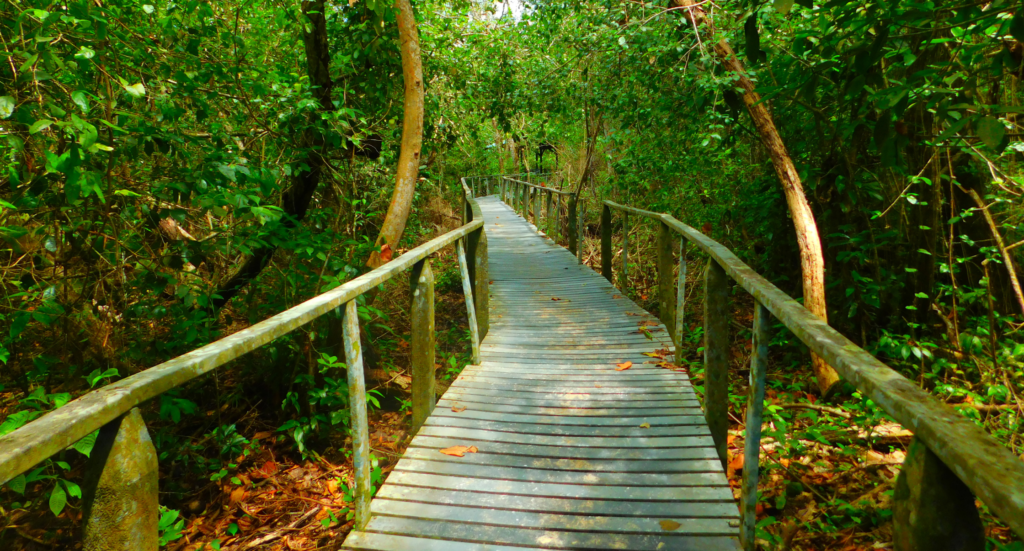
What Should You Actually Pack for Cahuita?
The Caribbean coast’s weather patterns demand specific preparation. Unlike the Pacific side where mornings stay dry even in rainy season, Caribbean weather shifts unpredictably year-round.
Essential items:
- Reef-safe sunscreen (required by law, enforced variably)
- Water shoes or sandals with heel straps for beach/reef walking
- At least 2 liters of water per person
- Quick-dry clothing (cotton stays wet for hours in this humidity)
- Waterproof bag for phone/camera
- Insect repellent with 20%+ DEET or picaridin
- Light rain jacket or poncho (even “dry” months get surprise showers)
Optional but useful:
- Binoculars for bird and monkey watching
- Underwater camera or waterproof phone case
- Extra shirt for sun protection (Caribbean sun is relentless)
- Small dry bag for keeping documents/valuables secure
- Hat or bandana
The park has no food services, but both entrances offer restrooms and showers. Pack snacks and lunch in paper bags or plastic boxes if you’re spending the full day. Small trash bags help—pack out everything you bring in.
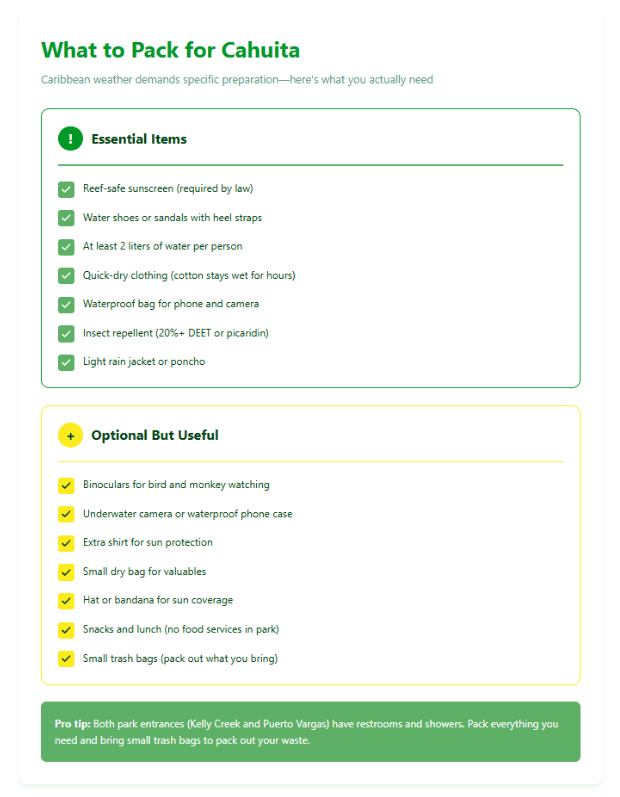
How Do You Get to Cahuita from San José or Liberia?
Cahuita sits on the Caribbean coast, 3.5 hours from San José via Route 32. This drive takes you through Braulio Carrillo National Park—one of Costa Rica’s most dramatic elevation changes as the highway climbs into cloud forest before descending to Caribbean lowlands.
From San José, head northeast on Route 32 toward Limón. The road stays well-maintained and doesn’t require 4×4, though you’ll navigate some winding mountain sections through Braulio Carrillo. After reaching Limón (the Caribbean coast’s main city), turn south on Route 36 for the final 45-minute stretch to Cahuita.
From Liberia (Guanacaste), you’re looking at 6-7 hours. Most travelers don’t make this drive in one day—it’s better suited for those already spending time in the Caribbean region or using Cahuita as part of a larger Caribbean coast exploration.
Having your own vehicle unlocks the Caribbean coast’s full potential. Beyond Cahuita, you can explore Punta Uva’s stunning beach (20 minutes south), Manzanillo Wildlife Refuge (40 minutes south), or head north to Puerto Viejo for restaurants and nightlife. The freedom to move between both park entrances and explore at your own pace makes the drive worthwhile.
Public transportation exists but requires patience. Buses run from San José to Cahuita (4.5-5 hours) via Limón, departing from Terminal Atlántico Norte. Once in Cahuita, everything’s walkable—the town stretches just a few blocks. However, accessing Puerto Vargas entrance without a vehicle means arranging a taxi or bike rental.
Where Should You Base Yourself: Cahuita Town or Elsewhere?
Cahuita town itself offers the most convenient base for exploring the park. This small Caribbean village maintains an authentic local vibe—no major resorts or chain hotels interrupt the laid-back atmosphere. Reggae music drifts from small bars, local sodas serve Caribbean-influenced casados with coconut rice, and the pace barely exceeds a crawl.
Accommodations range from $30-40 budget cabinas to $100-150 boutique hotels with ocean views. Most lodging sits within walking distance of Kelly Creek entrance (5-15 minute walk). The town’s compact size means everything—restaurants, small grocery stores, equipment rental shops—clusters along the main road and beach access roads.
Puerto Viejo (16km south) offers more dining and nightlife options while still providing easy access to Cahuita. This larger town has become the Caribbean coast’s tourism hub, with significantly more restaurant choices, tour operators, and evening entertainment. The 10-15 minute drive to Cahuita is negligible if you want more options for meals and activities beyond the park.
Punta Uva or Manzanillo work if you prefer quieter, more remote settings. These beach communities south of Cahuita offer stunning coastal scenery and excellent swimming, but you’ll drive 20-40 minutes to reach the park.

What Else Should You Know Before Visiting Cahuita?
Cell coverage is usually reliable in Cahuita town and the National Park although it is spotty along Route 36. Download offline maps beforehand for navigation or emergencies inside the park.
Swimming safety varies by beach section. La Boca (the river mouth 20 minutes walk in from the Kelly Creek entrance)Punta Cahuita (the peninsula) offers the calmest water, protected by the reef. Beach sections with more exposed coastline get stronger currents—watch for warning signs and ask rangers about conditions before swimming anywhere unfamiliar.
Theft concerns are minimal but not zero. Don’t leave valuables visible in your vehicle at either entrance. The parking areas see occasional break-ins.
Cultural respect matters on the Caribbean coast. The Afro-Caribbean communities here have distinct cultural traditions. Learn a few phrases in Caribbean English (the local dialect differs from standard Costa Rican Spanish), support local businesses, and approach interactions with genuine curiosity rather than entitled tourist expectations.
Combine your visit with other Caribbean coast highlights for the best experience. The Sloth Sanctuary of Costa Rica sits 30 minutes north, Jaguar Rescue Center operates near Puerto Viejo, and the beaches between Cahuita and Manzanillo rank among Costa Rica’s finest. Having a vehicle lets you create a 2-3 day Caribbean coast loop that covers multiple destinations efficiently.
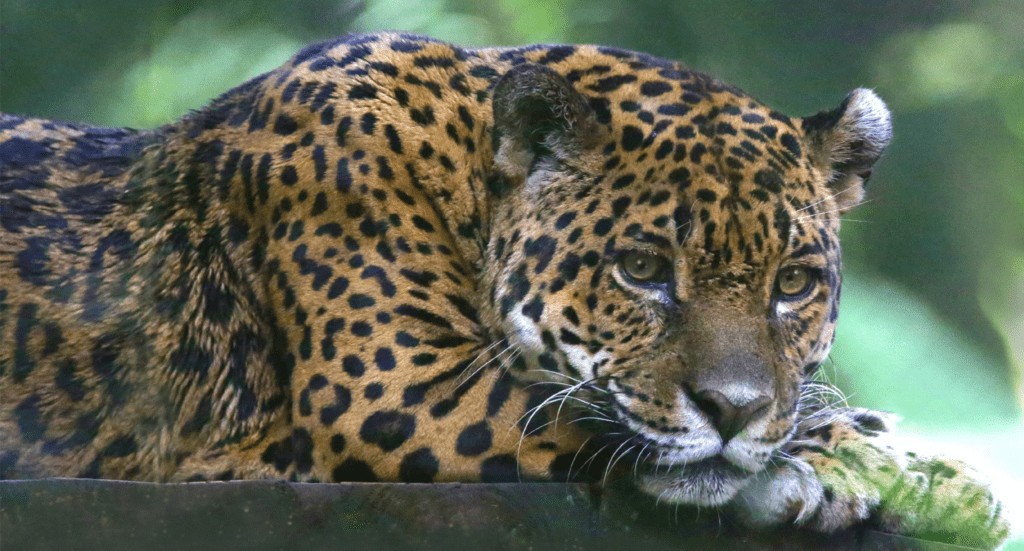
Ready to Explore Costa Rica's Caribbean Side?
Cahuita National Park delivers an experience completely different from the Pacific coast parks most visitors prioritize. The combination of accessible wildlife viewing, quality snorkeling, uncrowded trails, and authentic Caribbean culture creates a destination worth the drive from San José.
Start your visit early at Kelly Creek entrance to beat the heat, pack reef-safe sunscreen and plenty of water, and build flexibility into your timeline—Caribbean coast weather shifts faster than Pacific patterns. The 3km hike to Punta Cahuita hits the sweet spot for most visitors, offering excellent wildlife spotting and the park’s best snorkeling in a manageable half-day experience.
Your own vehicle transforms a Cahuita visit into a proper Caribbean coast exploration. The drive from San José takes you through spectacular Braulio Carrillo cloud forest, and once you’re based on the coast, you can easily combine the park with Punta Uva beach, Manzanillo Wildlife Refuge, and Puerto Viejo’s dining scene—creating an itinerary that captures the full Caribbean experience beyond just Cahuita itself.
Frequently Asked Questions
Is Cahuita National Park worth visiting?
Yes, especially if you want to skip the crowds at Manuel Antonio. Cahuita combines coastal rainforest hiking with Caribbean snorkeling in one spot, and you’ll spot howler monkeys, sloths, and capuchins without fighting through tour groups. The Kelly Creek entrance works on donations (suggested $5), making it one of Costa Rica’s most accessible parks. If you’re already exploring the Caribbean coast, it’s a must-do. If you’re only hitting Pacific destinations, the 3.5-hour drive from San José is harder to justify unless you’re spending several days in the region.
Do you need a guide for Cahuita National Park?
No. The 5-mile coastal trail is straightforward—you’re walking along the beach the entire time, so getting lost isn’t a concern. Wildlife spotting happens easily on your own since animals are active throughout the morning. That said, a local guide can identify birds you’d otherwise miss and knows exactly where sloths hang out in specific cecropia trees. If you’re really into wildlife photography or want to learn about the ecosystem, hire a guide at the Kelly Creek entrance ($20-30 per person). For most visitors, going solo works fine.
How long is the Cahuita National Park trail and how much time should you plan?
The full trail runs 5 miles (8km) one-way from Kelly Creek to Puerto Vargas, taking 3-4 hours without stops. Most people don’t do the entire thing. The sweet spot is hiking to Punta Cahuita (3km, about 90 minutes), spending time snorkeling at the point, then heading back the same way. This creates a manageable 4-5 hour experience that covers the park’s highlights without exhausting you in the Caribbean heat.
What’s the best time of year to visit Cahuita for snorkeling?
February through April gives you the clearest water—often 15-30 feet of visibility. The Caribbean doesn’t follow the Pacific’s predictable dry season pattern, but these months combine less rainfall with calmer seas for ideal snorkeling. September and October offer a second window with decent conditions and far fewer tourists. Skip December and January despite it being “dry season”—rough seas churn up sediment and visibility drops to just a few feet.
What should you pack for a day at Cahuita?
Reef-safe sunscreen (required by law), at least 2 liters of water per person, water shoes or sandals with heel straps, quick-dry clothing, a waterproof bag for your phone, insect repellent with 20%+ DEET, and a light rain jacket. The park has zero food services, so pack snacks and lunch. If you’re snorkeling, bring your gear or plan to rent in town beforehand. Don’t forget a small trash bag.
Is Cahuita or Puerto Viejo better for a base?
Cahuita wins for proximity to the park—you’ll walk to Kelly Creek entrance in under 10 minutes from most hotels. The town maintains a more authentic, laid-back Caribbean vibe with reggae bars and local sodas serving coconut rice. Puerto Viejo (6km south) offers significantly more restaurant variety, nightlife, and tour operators while still giving easy access to Cahuita with a 10-15 minute drive. Choose Cahuita if you want quiet beach town vibes and prioritize the park. Pick Puerto Viejo if you want more dining and evening entertainment options.
How do you get between the two park entrances?
Having your own vehicle makes this simple—it’s a 10-minute drive between Kelly Creek and Puerto Vargas entrances. Without a car, you have three options: hike the full 5-mile trail one-way (3-4 hours), arrange a taxi pickup at the opposite entrance before you start hiking ($10-15), or rent a bike in Cahuita town. Most visitors without vehicles just do an out-and-back hike to Punta Cahuita from Kelly Creek rather than trying to coordinate transportation between entrances.
